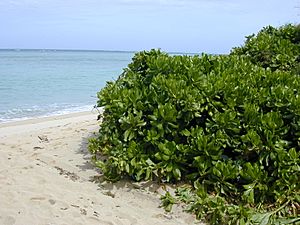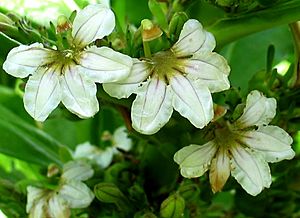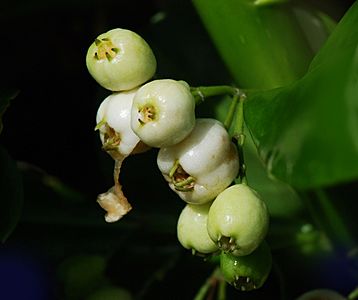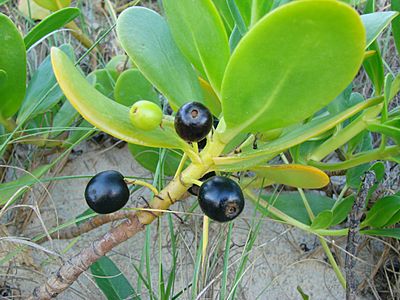Beach cabbage facts for kids
Quick facts for kids Beach cabbage |
|
|---|---|
 |
|
| In its typical habitat; Maui, Kanaha Beach | |
 |
|
| Flower | |
| Scientific classification | |
| Genus: |
Scaevola (plant)
|
| Species: |
taccada
|
| Synonyms | |
|
|
Scaevola taccada, also known as beach cabbage or beach naupaka, is a common flowering plant. You can find it growing along the coasts in warm, tropical parts of the world. This includes areas around the Arabian Sea, the Indian Ocean, and islands in the Pacific Ocean.
People sometimes call it by other names too. In Hawaiian, it's naupaka kahakai. In Divehi, it's magoo. And in Malay, it's merambong. For a long time, scientists were a bit confused about its exact scientific name. It is also known as Scaevola sericea.
Contents
What is Beach Naupaka?
Scaevola taccada is a large bush that can grow up to about 4 meters (13 feet) tall. It loves to grow very close to the sea, right on sandy or pebbly beaches. It can even handle the salty ocean spray!
Leaves, Flowers, and Fruits
The leaves of this plant are a bit thick and fleshy, like a succulent. They are about 20 cm (8 inches) long and grow close together at the ends of the stems. They are smooth and have a yellowish-green color.
The flowers and fruits are both white. Scaevola taccada blooms all year long. Its flowers look like a fan, which is why it's sometimes called a fanflower or half flower.
The fruits of the beach naupaka can float in seawater. This helps the plant spread its seeds to new places. It's often one of the first plants to grow on new sandbanks or islands in tropical areas.
Beach Naupaka vs. Other Plants
Scaevola taccada looks a lot like another plant called Scaevola plumieri. Both were once thought to be the same species. But there's a way to tell them apart!
- S. taccada has small leaf-like parts (called calyx lobes) that you can clearly see on its white fruits.
- S. plumieri has very small or no calyx lobes on its calyx, and its fruits turn black when they are ripe.
Where Does Beach Naupaka Grow?
This plant is found in many coastal areas around the world. You can see it on beaches in:
- Okinawa
- Taiwan
- Southern China
- Vietnam
- Malaysia
- Philippines
- Indonesia
- East Timor
- Northern Australia
- Islands in Polynesia, Melanesia, and Micronesia
- East Africa
- Madagascar
- Mauritius
- Seychelles
- Oman
- Yemen
- India
- Maldives
- Burma
- Thailand
- Cambodia
- Chagos Islands
- Comoros
- Réunion
Its Favorite Home
Scaevola taccada loves to grow right on tropical beaches. It especially likes the sandy parts of coral coasts. It thrives in areas where it gets a lot of salt spray from the ocean. This plant is often one of the first to grow on new atolls and sandbanks. It's easy to grow from seeds or even from cuttings.
It prefers sandy soils that drain water well. It's also very good at handling salty conditions. You'll often find Scaevola taccada growing with other beach plants. These include coconut palms, soldierbush, beach morning glory, and beach gardenia. It's a plant often seen on tropical island postcards!
How People Use Beach Naupaka
On some Pacific islands, Scaevola taccada is used to help stop coastal erosion. This means it helps prevent the sand from washing away from the beaches. People also plant it for landscaping. It's also planted on beach edges to protect other plants from salty ocean spray.
Some parts of the plant are used in traditional medicine in Polynesia and Asia. In the Maldives, people historically ate the leaves of this plant when there wasn't much other food available.
When it Becomes a Problem
In some places, like parts of the United States (Florida, Puerto Rico, US Virgin Islands), the Caribbean nations, and the Bahamas, Scaevola taccada has become an invasive species. This means it grows too much and pushes out the native plants, like the Caribbean Scaevola plumieri, from their natural homes.
Images for kids
-
Habitat, Seychelles
-
Closeup of a flower from Andhra Pradesh, India
-
Fruits, Maui, Kihei
-
Clusters in Ap Lei Chau, Hong Kong.













